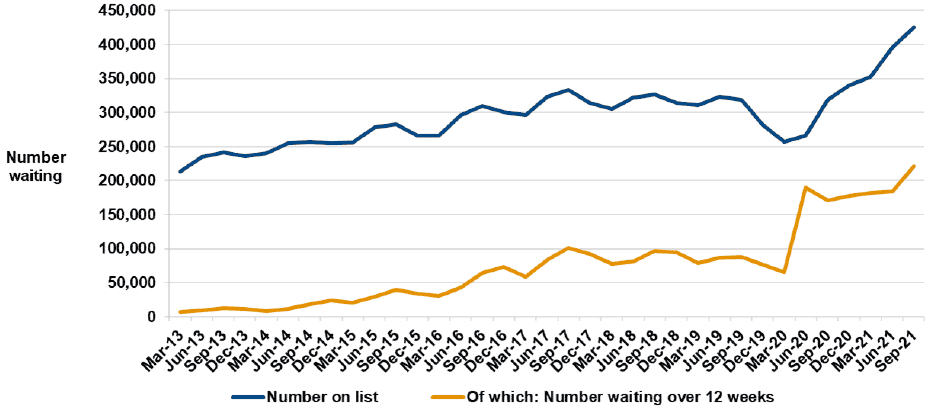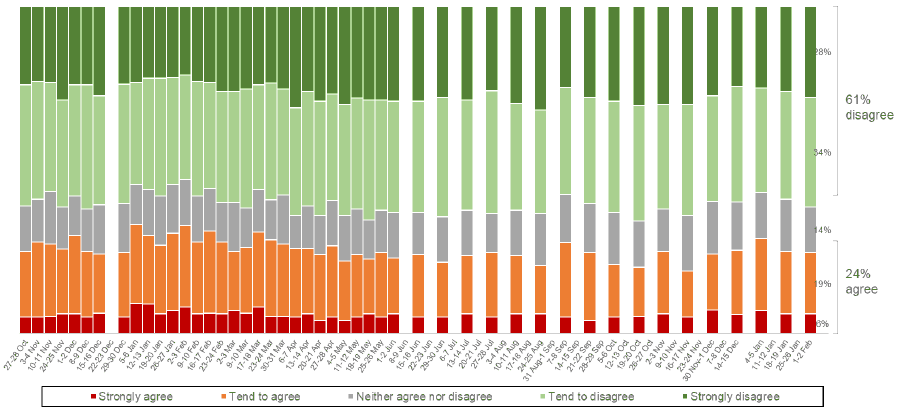Coronavirus (COVID-19) Scotland's Strategic Framework update – February 2022: evidence paper
This evidence paper accompanies the Strategic Framework update and provides an overview of the key analysis and evidence underpinning the Framework, published on 22 February 2022.
3. Health and Social Care in Scotland
3.1 Introduction
The COVID-19 pandemic has affected demand, attendances, planned and unplanned care and waiting times across NHS Scotland and social care in a number of ways. Approaching two years of the NHS being on an emergency footing, demand continues to be very significant. System capacity has been impacted by COVID-19 infection control requirements, redeployment of staff, capacity to treat COVID-19 patients, delayed discharges and COVID-19 related staff absences. The Scottish Government has published the NHS Recovery Plan that sets out key ambitions and actions to be delivered now and over the 5 years to address the backlog in care and meet ongoing healthcare needs for people across Scotland.
3.2 Hospital and GP services
Large decreases in attendances at A&E services in NHS Scotland were observed in spring 2020 and winter 2020/21. Since spring 2021 attendances at A&E have been rising and are getting closer to the pre-COVID levels. From the summer of 2021 performance against the four hour standard has dropped below 80%. During December 2021, there were 110,934 attendances at A&E services in Scotland; of these, 75.7% of attendances at A&E services were seen and resulted in a subsequent admission, transfer or discharge within 4 hours.[116]

There has been a large increase in the number of people waiting to be seen as outpatients.[117] At 30 September 2021, 425,242 patients were waiting to be seen as outpatients, 33% higher than at 30 September 2020. People are also typically waiting longer to be seen. For example, 48% of people had been waiting 12 weeks or less at the quarter ending 30 September 2021, markedly down on the 73% reported on average in 2019. During the quarter ending 30 September 2021, 286,935 new outpatients were seen. This is 121% higher than the 129,944 patients seen in the quarter ending 30 June 2020, during the first wave of the pandemic, but 22% lower than the quarterly average of 367,226 during 2019, prior to the onset of the pandemic.

There has also been an increase in the number of patients waiting to be admitted as inpatients or day cases covered by the Treatment Time Guarantee (TTG).[118] At 30 September 2021, 106,496 patients were waiting to be admitted for treatment, 25% higher than at 30 September 2020. Of those waiting, 37% had been waiting 12 weeks or less, markedly down on the 69% reported at the end of quarters in 2019. The reduction in activity is also reflected in the number of patients admitted for treatment under TTG. During the quarter ending 30 September 2021, 45,449 patients were admitted for treatment. This is 210% higher than the 14,673 patients seen in the quarter ending 30 June 2020, during the first wave of the pandemic, but 36% lower than the quarterly average of 70,594 during 2019, prior to the onset of the pandemic.
During quarter ending 30 September 2021, there were 4,011 eligible referrals for the 62-day cancer treatment standard, a 31.6% increase compared with quarter ending 30 September 2020.[119] During quarter ending 30 September, 83.1% of patients started treatment within the 62-day standard compared to 87.3% for quarter ending 30 September 2020. There were 6,329 eligible referrals within the 31-day standard during quarter ending 30 September 2021, a 27.4% increase compared with quarter ending 30 September 2020. During quarter ending 30 September, 96.7% of patients started treatment within the 31-day standard compared to 98.4% for quarter ending 30 September 2020.
GP services, and the progress with plans to redesign[120] these, have been impacted by the COVID-19 pandemic. Some services were paused or altered during 2020, including the reduction of appointment times, restrictions to patient capacity and workforce reallocation. Many appointments shifted to telephone or video consultations, with face-to-face appointments offered following telephone triage where necessary.
There has been a reluctance among some to seek non-COVID-19 healthcare treatment during the COVID-19 pandemic. Since the end of October 2021 between 20-29% of people agreed or strongly agreed that they would avoid contacting a GP practice at the moment even if they had an immediate medical concern (not related to Coronavirus)[121]. Responses were broadly similar across different groups of the population. The most recent data shows that in early February 2022, the proportion of people who agree that they would avoid contacting a GP practice for immediate non-COVID-19 health concerns was 24%.

The COVID-19 pandemic has resulted in severe and sustained impacts on social care services over the last two years, with the latest comparable data showing COVID-19 deaths in care homes, since the start of the pandemic up to 6 February 2022, as amounting to 29% of all COVID-19 deaths in Scotland. The effects of the pandemic have been wide-ranging and have impacted on current wider social care system pressures, with for example, the number of people whose discharge from hospital was delayed increasing to almost 1,400 in December 2021, up from around 1,000 in the first half of 2021.
3.3 Population Health
The COVID-19 pandemic has seen the introduction of a range of restrictions at various stages of the pandemic that has affected our day to day lives in our communities and has affected how our health, education and other public services have functioned. This likely to have impacted in different ways on population health at various stages in the life-course, well beyond the direct impacts of COVID-19.
Many people who have experienced severe COVID-19 disease, or died with COVID-19, have pre-existing health conditions including dementia, Alzheimer’s disease, diabetes, cardiovascular disease, chronic obstructive pulmonary disease, kidney disease and other chronic conditions. Further, and to some extent associated with multi-morbidity, the health impact of COVID-19 has not been shared equally. After adjusting for age, up to December 2021, people in the most deprived areas were 2.5 times more likely to die with COVID-19 than those living in the least deprived areas[122]. Recent work by PHS and partners showed that the extent of inequality due to COVID-19 was similar to averting all annual Disability Adjusted Life Years (DALYs) due to diabetes[123].
The impact of Long-COVID has yet to be fully understood and has implications for health care in the future. An estimated 1.3 million people living in private households in the UK (2% of the population) were experiencing self-reported Long-COVID symptoms according to the ONS Infection Survey as of 2 January 2022. The equivalent estimate for Scotland, is 100,000 people and 1.9% of the population[124]. These are symptoms persisting for more than four weeks after the first suspected coronavirus (COVID-19) infection that were not explained by something else[125]. Notably, receiving two doses of a coronavirus (COVID-19) vaccine at least two weeks before a first test-confirmed COVID-19 infection was associated with a 41% decrease in the odds of self-reported Long-COVID at least 12 weeks later, relative to similar study participants who were not vaccinated when infected.
The most recently published evidence on the impact of COVID-19 on health behaviours that impact on population health is mixed. It shows a mix of both stable, positive and negative change on health behaviours, such as alcohol and tobacco consumption, diet and physical activity.
For example:
- A range of survey studies suggest that up to around a fifth of the adult population self-report drinking more than prior to the pandemic with a similar proportion drinking less[126]. This may explain why the evidence suggests an overall reduction, at least earlier in the pandemic. Alcohol sales data suggests the impact between March and July 2020 was to have reduced overall consumption levels by 6% with an observed 28% increase in off-trade sales not compensating for the loss in on-trade sales in terms of pure alcohol sold per adult in Scotland[127].
- The Scottish Health Survey found that 55% of smokers self-reported no change in their smoking habits since the start of the March 2020 lockdown, but 36% reported smoking more[128]. The Smoking Toolkit Study has tracked cigarette smoking over time and shows, for Scotland, that overall prevalence increased from 13.1% of the population in December 2020 to 16.3% in November 2021, bucking a longer-term downward trend and largely driven by those aged over 35 years[129].
- A recently published longitudinal study of a large number of people in England indicated that most people retained stable levels of physical activity (including those who were inactive) during the first strict lockdown and after all restrictions to physical activity were lifted (23 March to August 2020). However, 28.7% showed a decline in activity levels over this period compared to 9% who increased[130]. We can reasonably expect that something similar has occurred also in Scotland.
- Recent data showed a marked increase in the proportion of young children in Scotland (Primary 1, age around 5 years) who were classed as at risk of being either overweight or obese in school year 2020/21 (29.5%) compared to 2019/2020 (22.7%). The proportion had been stable for many years prior to this[131]. The largest change was observed in those living in the most deprived areas.
3.4 Mental Health
The most recently published waves of the Scottish COVID-19 Mental Health tracker Study and the Coronavirus Impact on Wellbeing survey provide insights into the population’s mental health and wellbeing during the lockdown in early 2021[132]. These surveys were conducted in February and March 2021 and the key findings were:
- 39% reported feeling lonely at least some of the time
- 32% reported psychological distress to a level that indicated a possible psychiatric disorder
- 24% reported moderate to severe depressive symptoms
- 16% reported moderate to severe anxiety symptoms
- 10% reported suicidal thoughts within the week prior to completing the survey
The following groups tended to report poorer mental health and wellbeing (e.g. higher rates of anxiety and loneliness):
- Younger adults
- Women
- Individuals with a physical and/or mental health condition
- Those with low household incomes or from lower socio-economic group
- Those who live alone.
A representative survey[133] conducted between February and April 2021 provides the most recent data on secondary school-children (11 to 18 years old). Similar to the surveys of adults; female students and those with a physical and/or mental health condition were found to report poorer mental health and wellbeing. However, in contrast with the adult samples of the other surveys, older pupils were found to report poorer mental health and wellbeing than younger pupils.
3.5 Summary
The COVID-19 pandemic has had a very substantial and sustained impact on the NHS and social care in Scotland. Organisational and individual responses to the pandemic have affected demand on the system, attendances, planned and unplanned care and waiting times across NHS Scotland. In social care, the effects of the pandemic have been wide-ranging and have impacted substantially on existing social care system pressures, with, for example, the number of people whose discharge from hospital being delayed increasing again in recent months.
There has also been an impact on the health of the Scottish people in a whole range of ways, many of which are yet to manifest themselves, or we have yet to fully understand. These negative impacts are experienced across the population, in different ways and at various stages of the life-course. However, the pandemic has clearly exacerbated existing health inequalities, exemplified by the data presented here on deaths and Disability Adjusted Life Years (DALYs)
Contact
There is a problem
Thanks for your feedback